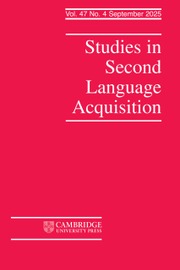GENERALIZABILITY AND AUTOMATICITY OF SECOND LANGUAGE LEARNINGUNDER IMPLICIT, INCIDENTAL, ENHANCED, AND INSTRUCTED CONDITIONS
Published online by Cambridge University Press: 01 June 1997
Abstract
This experimental study examines the extent to which 60 adult Japanese ESL learners wereable to acquire a rule regulating the argument structure frames of novel verbs of English afterexposure to grammatical examples of sentences containing the verbs. Training took place underconditions with no focus on form (implicit and incidental conditions) and with focus on form(enhanced and instructed conditions). The presentation of instances during training wasmanipulated as a test of predictions made by Logan's (1988, 1990, 1992) memory-basedinstance theory of automaticity. Results measured in reaction times show similarslopes for automaticity on trained examples in each condition but significant differences in theextent of learning, with the focus on form conditions outperforming the no focus on formconditions in transfer of learned knowledge to accurate judgments of new ungrammaticalsentences. Implications are drawn from the results regarding the acquisition of rule-based versusmemory-based knowledge from exposure to stimuli in each training condition and the influenceof this knowledge on decision-making about grammaticality during the transfer task.
Information
- Type
- Research Article
- Information
- Copyright
- © 1997 Cambridge University Press
Footnotes
- 124
- Cited by

